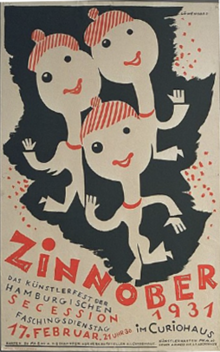Cinnabar (solid)

Cinnabar was the title that the Hamburg Secession gave its carnival festivals from 1928 to 1933. They were independent festivals in addition to the well-known Hamburg artist festivals , like this one in the Curiohaus on Rothenbaumchaussee. The title was based on the cinnabar festivals organized by Kurt Schwitters in Hanover in the 1920s. The decorative equipment of the events was less spectacular than that of the artist festivals, the focus was on the use of the carnival for a cultural-political satire up to accounting.
The members of the Secession dressed uniformly for these festivals with red caps and sweaters and white trousers. Presented were revues and attractions, we held on the first of cinnabar an "art destruction cabinet" during which should be shot at art. The celebrations were accompanied by the publication of leaflets and almanacs with ironic, critical but also self-critical statements. In particular, the publications by Karl Kluth , with which "the German philistine mentality" and the military spirit of National Socialism as well as its narrow-mindedness was attacked, were considered to be written with a sharp pen and sometimes led to notifications and lawsuits. Other secessionists whose active participation in the Zinnobern has been passed down were Willem Grimm , Hans Leip , Ernst Lewalter , Dorothea Maetzel-Johannsen , Emil Maetzel , Fritz Kronenberg and Otto Tetjus Tügel .
literature
- Maike Bruns: Art in Crisis. Hamburg art in the “Third Reich”. Dölling and Galitz Verlag, Munich 2001, ISBN 3-933374-94-4 .
- Edith Oppens: The Mandrill. Hamburg's twenties. Erik Blumenfeld Seaport Publishing House, Hamburg 1969.